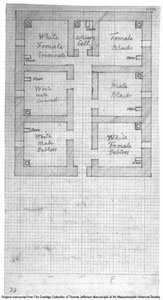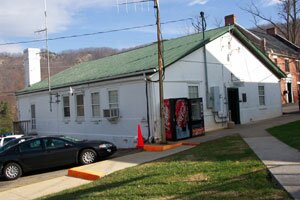ON ARCHITECTURE- Jefferson's jail: Lovingston's new discovery
Published January 26, 2006 in issue 0504 of the Hook
BY DAVE MCNAIR [email protected]
For generations, rumor had it that the Nelson County Courthouse in Lovingston was designed by Thomas Jefferson. So what else is new? As UVA architecture professor Richard Guy Wilson jokes, "There are similar rumors about almost every building around with red brick and white trim."
The problem, says Wilson, is that 220 people worked on building the University of Virginia, along with another 120 or so subcontractors. Many of these people adopted Jefferson's design schemes in their own projects across the state.
For example, Thomas Blackburn, one of Jefferson's architects, was obviously influenced by his boss. Blackburn designed the Western State Lunatic Asylum in Staunton, a huge complex of buildings that are noticeably "Jeffersonian" in design. Jefferson's designs were so impressive-- especially to people who worked on projects with him-- that other buildings around the time were bound to display evidence of his influence.
Unfortunately, an architectural survey of Lovingston's historic district-- conducted as part of the town's bid for inclusion in the National Register of Historic Places-- revealed that Jefferson had nothing to do with the old courthouse.
"While Jefferson was known to design courthouses throughout Virginia... and even given the fact that his two-story, temple-fronted Virginia State Capitol of 1785 was tremendously influential on the design of governmental buildings," the survey stated, "no evidence has been found to tie him to the Lovingston Courthouse."
What a blow to Lovingston's bid for historical designation. Surely, a Jefferson-designed anything would make it a shoo-in for the historic register.
But as luck would have it, the survey turned up something even better: a real TJ building.
"Not one of his best," says UVA's Wilson, "but an interesting example."
In the course of her survey work, Jennifer Hallock of Arcadia Preservation, the firm performing the survey, and Robert Self, an architectural conservator at Monticello, discovered proof that the sheriff's office in Lovingston was designed by Thomas Jefferson.
After digging up a surviving jail design in the Jefferson Archives of the Massachusetts Historical Society, as well as correspondences between Jefferson and the men who commissioned the jail, Hallock and Self matched the design with the existing structure.
"Jefferson made the design for a jail in Cumberland," says Hallock, "but when Joseph Cabell commissioned a jail for Lovingston, it appears that the same design was used." Hallock also points to a letter Cabell wrote to Jefferson in 1823 informing him that his "scheme, with some modification, had been approved."
Although the building is no longer a jail, and despite the fact that much of the original design has disappeared under years of "improvements"-- '70s-style wood paneling, false ceilings, and fluorescent lights-- the footprint of the building is unmistakably Jeffersonian.
"The floor plan for the building was only off by a few inches according to the design we found," says Hallock. "I wasn't really looking for it when I started, but there it was. The original penciling on the brick, the {dentil molding}, plus the letters that confirm that Jefferson's design was used. In fact, it may have been one of the last things Jefferson designed." The jail was built in 1823, and Jefferson died in 1826.
Of course, to the untrained eye it's almost impossible to recognize the Sheriff's Office as a Jefferson designed jail. The simple single-story structure has been painted white and could now be mistaken for an early convenience store. Still, according to Nelson County administrator Stephen Carter, the discovery is no news to old-timers.
"Even before I got here in 1998, the locals who had been here the longest knew that was Jefferson's building," Carter says. However, Self says that when he began asking locals about the possible existence of the jail, people told him it had been torn down years ago.
The Massachusetts Historical Society archives include a page of Jefferson's notes on the project, which reflect a kinder-gentler approach to prison design. In fact, one of the reasons the new jail was commissioned was that prison sanitary regulations had recently been changed.
For example, Jefferson calls for the "necessary" in each cell to have a "tight lid" and behind it "in the external wall should be an arch high and wide enough to draw out the odor." Not exactly the Declaration of Independence, but one can imagine that previous jails had no such luxury.
Additionally, the notes call for a sheet iron floor, which Jefferson says will be easier to keep clean and also provide added security. Each room is carefully assigned to a class of prisoner, for example: White Male Debtors, White Female Debtors, Black Male Criminals, White Male criminals, etc. Of course, it being a jail and not a hotel, Jefferson also adds a solitary cell to "put ill-behaved prisoners into occasionally, as a punishment."
As far as Holluck and Self are concerned, these revelations came just in time. "We're stressed for space," says Carter, "At one point the Board of Supervisors thought they might have to move the building."
Now that it appears to be a Jefferson design, those plans may have to change. "More recently," says Carter, "the Board seems to have decided to preserve the building. They've asked the architect to come up with another plan for the courthouse project."
Holluck also thinks the Board intends to preserve the building. "At a recent meeting I went to, three out of five board members seemed to be leaning toward saving it," she says, "but we'll have to wait and see."
According to Carter, the fate of Jefferson's jail should be decided by the end of February.

Original plan of Jefferson's jail design from a collection in the Massachusetts Historical Society
MASSACHUSETTS HISTORICAL SOCIETY PHOTO

Lovingston's Sheriff's Office may have been one of Jefferson's last designs
PHOTO BY JENNIFER HALLOCK
#
|